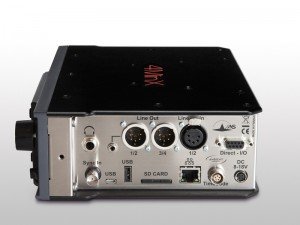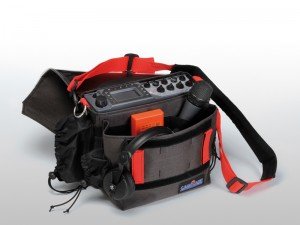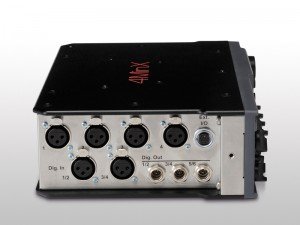AETA have been a big name in radio reporter’s gear for ever but it was only a couple of years ago that I had a chance to review their Mixy three channel location mixer. While working on the Mixy review I discovered AETA have something of a cult following for their now discontinued mic amps and I was certainly impressed by the audio quality of the somewhat physically quirky Mixy. I still think it is a great product, it just doesn’t present itself the way most of the competition goes about things. And I think that is a pretty good introduction to AETA’s 4MinX mixer/recorder package.
Stand by for a blast of spec. Four mic/line inputs, separate stereo line input, two AES 3 digital inputs which can also be configured as AES 42 allowing the connection of up to four digital microphones. Multiple output options including Hirose ten way or and additional (making two in total) five pin XLRS for balanced analogue, stereo minijack for unbalanced analogue. Direct analgoue outputs to feed radio transmitters. Three AES 3 outputs on TA3 outputs. Direct outputs 1—4 on nine pin D connector and last but not least a quarter inch jack for your headphones.
The 4MinX is powered by an onboard Sony style camcorder battery very much like the Sound Devices 744T, or externally by the standarish Hirose four pin socket. The machine contains on board charging for the Sony battery. Command and control is available via a three inch colour screen, a full transport section and some custom buttons running up the vertical edges of the screen alongside a large encoder. A comprehensive on board Ambient timecode system is available as an option.
The 4Minx is well screwed together and the extensive use of plastics keeps the weight well down. Even with a battery on board I was constantly surprised by how light it is. The pots are on the small side but then so is the package, this really is a device you can use `over the shoulder’, rather than parked on a trolley. The audio quality is impeccable, I think the AETA mic amps deserve all the praise they get. Don’t ask me is it better than the HyperTastic 414, the older I get the less I worry about that. More to the point, no one should spend three grand plus on a mixer or recorder without listening to it themselves.
The mixer side of the front panel has four knobs for level control of channels one to four, and each of these channels has a pair of dedicated control buttons and simple led metering. Also on the front panel four assignable encoders and a master control. The AETA records to SD card and can back up to an external USB device hard disk, note not USB stick.
You will have gathered already that the 4Minx is all about customisation. For instance it is not a track based recorder but rather a file based one. You can specify eight different file presets in the file management menu. Each preset can be mono, stereo or polyphonic. The clever bit is you can record different file formats simultaneously, with the proviso that each input can be used only once within file management. Each of the ten inputs is available pre or post fader together with the main mix adding up to a total of twenty twenty two options. A fully loaded 4Minx can record any eight of these sources in any combination. So you can easily set up your recorder to record inputs one to four post fader, but have a different file setting available to record the four mic inputs prefader, and changing will take two seconds. And we always want to save two seconds. In fact if you have the eight track record enabled you could record both at the same time.
One downside of the flexibility is the intitial investment of your time to explore the depth of the system and choose the workflow that suits you. It also makes reviewing a little tricky as there so many ways to set the 4Minx up it’s not easy to guage whether you really are using it in the optimum way. For instance — you have four function keys on the left hand side of the screen each of which can be `shifted’ in conjunction with the shift key to give you eight options. These keys interact with the plus and minus keys on the four main inputs to offer rough gain changing (ten dB steps), solo functionality, enabling the limiters on the channels, applying the high pass filter and so forth. I’m very happy with that, though I’d rather the rough gain was variable rather than coming in ten dB lumps. One very cute touch, in solo mode the plus key selects post fade solo while the minus key offers preface soloing, very logical, n’est ces pas?
These function keys are also available to recall snapshots and choose between monitoring functions. Press the monitoring key and you have four different monitor options at your fingertips, the shift key gives you another four. While this level of customisation is a bit fierce out of the box or in a review, a long term user will be able to set the AETA up exactly how they want it.

One of the main strengths of the 4Minx is music recording. Not only does it sound good, it can record eight tracks at 96kHz. It can accept AES 42 digital mics and has custom monitoring set ups for the Soundfield system available as an option. I was fortunate enough to have a Soundfield SPS200 for review with the AETA and together the system was a joy to use. I was transported back to the olden days of marching into a venue, nominating the spot for the `honk stick’ (Neumann SM69), rigging in two minutes and having a cup of tea. Soundfield and AETA have worked together to provide comprehensive configuration and monitoring for Soundfield mics. This made using the SPS200 a joy, literally plug and play. You even get graphics of the mic to help you choose the orientation set up of the software, a really tidy implementation.
Needless to say you’ll want a fast SD card to whack all the data on, especially at high sample rates. And you’ll need a USB drive to back up your best work when you get a chance. There are two USB connectors, one full fat A style for keyboard on indeed a midi controller like the KORG nanoKontroller, and a micro A connector for hard drives for back up. With the nanoKontroller plugged in you have faders and pots nicely presented, and record and stop under midi control. And all for under forty quid.
One very distinctive aspect of the 4Minx is the pricing. AETA offer the hardware as a stand alone mixer (in the UK the price for this configuration is under three grand ex VAT) and you can then add options recording two, four, six or eight tracks, timecode, Soundfield monitoring and the Hirose ten way option for camera connection. The good news is the ability to keep the cost down if you want a simple system and the recording options are software unlocks. The trickier decision is while not everyone wants say timecode, we’d all like to have it for that one off job and the machine would have to go back to France for the retro-fit. On the other hand the Sony batteries are cheap as is the midi control option.
Summing up the 4Minx is as complex as the machine itself. The recording quality is undoubtedly at the high end of the scale and if you are thinking about a Nagra 6 or 788T you should certainly not buy one of those without having a demo of the 4Minx. If your TV or Film work demands 96kHz then you should have a demo of the 4Minx. I would flag up that it is a complex machine and half an hour in any sort of rush and you won’t see the 4Minx at its best. I recommend getting hold of your local AETA rep (John Willet in the UK) and spending some time with the 4Minx. It’s a machine with a certain je ne sais quoi!


